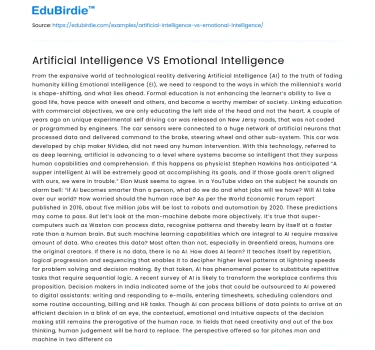From the expansive world of technological reality delivering Artificial Intelligence (AI) to the truth of fading humanity killing Emotional Intelligence (EI), we need to respond to the ways in which the millennial’s world is shape-shifting, and what lies ahead. Formal education is not enhancing the learner’s ability to live a good life, have peace with oneself and others, and become a worthy member of society. Linking education with commercial objectives, we are only educating the left side of the head and not the heart.
A couple of years ago an unique experimental self driving car was released on New Jersy roads, that was not coded or programmed by engineers. The car sensors were connected to a huge network of artificial neurons that processed data and delivered command to the brake, steering wheel and other sub-system. This car was developed by chip maker NVidea, did not need any human intervention. With this technology, referred to as deep learning, artificial is advancing to a level where systems become so intelligent that they surpass human capabilities and comprehension. If this happens as physicist Stephen Hawkins has anticipated “A supper intelligent AI will be extremely good at accomplishing its goals, and if those goals aren’t aligned with ours, we were in trouble.”
Save your time!
We can take care of your essay
- Proper editing and formatting
- Free revision, title page, and bibliography
- Flexible prices and money-back guarantee
Elon Musk seems to agree. In a YouTube video on the subject he sounds an alarm bell: “if AI becomes smarter than a person, what do we do and what jobs will we have? Will AI take over our world? How worried should the human race be? As per the World Economic Forum report published in 2016, about five million jobs will be lost to robots and automation by 2020. These predictions may come to pass. But let’s look at the man-machine debate more objectively. It’s true that super-computers such as Waston can process data, recognise patterns and thereby learn by itself at a faster rate than a human brain. But such machine learning capabilities which are integral to AI require massive amount of data.
Who creates this data? Most often than not, especially in Greenfield areas, humans are the original creators. If there is no data, there is no AI. How does AI learn? It teaches itself by repetition, logical progression and sequencing that enables it to decipher higher level patterns at lightning speeds for problem solving and decision making. By that token, AI has phenomenal power to substitute repetitive tasks that require sequential logic.
A recent survey of AI is likely to transform the workplace confirms this proposition. Decision makers in India indicated some of the jobs that could be outsourced to AI powered to digital assistants: writing and responding to e-mails, entering timesheets, scheduling calendars and some routine accounting, billing and HR tasks. Though AI can process billions of data points to arrive at an efficient decision in a blink of an eye, the contextual, emotional and intuitive aspects of the decision making still remains the prerogative of the human race. In fields that need creativity and out of the box thinking, human judgement will be hard to replace.
The perspective offered so far pitches man and machine in two different camps, with the debate focusing on who will reign supreme. But recent developments in the field suggest it doesn’t have to be that way. There can be a third side. The merging of man-machine to create a powerful combined force. Elon Musk has already founded a company called Neuralink, which is in process of discovering and developing devices that can connect to the brain. Ray Kurzwell, a futurist and Google’s AI guru, believes the world is experiencing one of the most peaceful times in history since World War – II. While hunger rates are lower than what they were in past, technology has lifted millions out of poverty and made it possible for three billion people to have smartphones.
He thinks the human race is at an evolutionary inflection point where man and machine will become one in the near future. Instead of being in separate camps and humanity living in existential fear of whether AI will take over our world, he believes “Robots will go inside our brain and connect to our neocortex by the year 2029.”






 Stuck on your essay?
Stuck on your essay?

